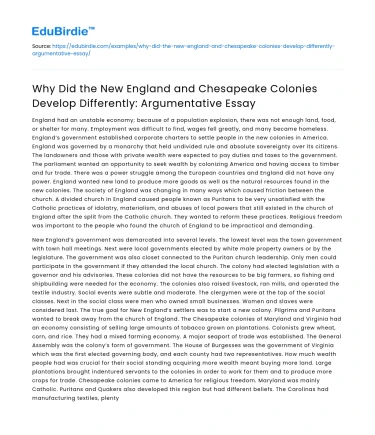England had an unstable economy; because of a population explosion, there was not enough land, food, or shelter for many. Employment was difficult to find, wages fell greatly, and many became homeless. England’s government established corporate charters to settle people in the new colonies in America. England was governed by a monarchy that held undivided rule and absolute sovereignty over its citizens. The landowners and those with private wealth were expected to pay duties and taxes to the government. The parliament wanted an opportunity to seek wealth by colonizing America and having access to timber and fur trade. There was a power struggle among the European countries and England did not have any power. England wanted new land to produce more goods as well as the natural resources found in the new colonies. The society of England was changing in many ways which caused friction between the church. A divided church in England caused people known as Puritans to be very unsatisfied with the Catholic practices of idolatry, materialism, and abuses of local powers that still existed in the church of England after the split from the Catholic church. They wanted to reform these practices. Religious freedom was important to the people who found the church of England to be impractical and demanding.
New England’s government was demarcated into several levels. The lowest level was the town government with town hall meetings. Next were local governments elected by white male property owners or by the legislature. The government was also closet connected to the Puritan church leadership. Only men could participate in the government if they attended the local church. The colony had elected legislation with a governor and his advisories. These colonies did not have the resources to be big farmers, so fishing and shipbuilding were needed for the economy. The colonies also raised livestock, ran mills, and operated the textile industry. Social events were subtle and moderate. The clergymen were at the top of the social classes. Next in the social class were men who owned small businesses. Women and slaves were considered last. The true goal for New England’s settlers was to start a new colony. Pilgrims and Puritans wanted to break away from the church of England. The Chesapeake colonies of Maryland and Virginia had an economy consisting of selling large amounts of tobacco grown on plantations. Colonists grew wheat, corn, and rice. They had a mixed farming economy. A major seaport of trade was established. The General Assembly was the colony’s form of government. The House of Burgesses was the government of Virginia which was the first elected governing body, and each county had two representatives. How much wealth people had was crucial for their social standing acquiring more wealth meant buying more land. Large plantations brought indentured servants to the colonies in order to work for them and to produce more crops for trade. Chesapeake colonies came to America for religious freedom. Maryland was mainly Catholic. Puritans and Quakers also developed this region but had different beliefs. The Carolinas had manufacturing textiles, plenty of water, forests, cotton, rice, and tobacco. South Carolina was one of the wealthiest early colonies. South Carolina relied on slaves to grow rice and cotton while North Carolina was tobacco farmers. The geographical differences along with political differences caused the Carolinas to split. The proprietors gave the Carolinas different governors. Quakers were some of the first settlers of North Carolina and the Church of England was North Carolina’s religion. The religion of South Carolina was the protestant religion.
Save your time!
We can take care of your essay
- Proper editing and formatting
- Free revision, title page, and bibliography
- Flexible prices and money-back guarantee
The English colonies encountered a totally different environment when they started to colonize America. They had no knowledge or skills that would help make them successful. The Native Americans were unsure and skeptical of the colonists since their dealings with the Spaniards. The Indians keep them from starvation by teaching them to plant crops, hunt for food, and how use the land and other natural resources. The Indians wanted to learn about the tools and weapons that the colonists brought with them. The two groups of people had to learn to communicate in order to trade for goods and teach each other new skills. Both groups benefited by sharing knowledge and keeping the peace.
Both men and women servants worked for years to pay for their passage to America. They were vital to the colonial economy as they worked for free to pay their way to America. Male servants were skilled laborers who worked with their hands as blacksmiths and more. Women servants did domestic chores like laundry, sewing, and cooking. The wealthy bought slaves due to the fact that they are more costly than servants. In 1670, slavery was introduced in Carolina.
England started colonies in Native America for several reasons, and one was to establish homes and farms. The English settlers wanted to make a stable and successful life for themselves. They established a relationship with the natives to learn from them. The population of the English colonies grew from the promotion of the indention servants, who after their indention was completed, bought land, had families, and started businesses. The colonies were financed by joint stock companies that had an interest in financial growth and provided for settlers to come to America. The English colonies became prosperous because of a profitable trading system. Colonial trade centered around a variety of raw materials. Also, fishing, lumbering, shipbuilding, and iron-making were important items used for trade. Determination, a strong work ethic, and a strong focus on building the future made the English colonies powerful. Their abundant amount of resources and their diverse population also made them powerful.






 Stuck on your essay?
Stuck on your essay?

